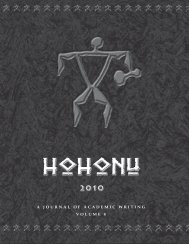Insect Conservation Summary Objectives Materials Making ...
Insect Conservation Summary Objectives Materials Making ...
Insect Conservation Summary Objectives Materials Making ...
Create successful ePaper yourself
Turn your PDF publications into a flip-book with our unique Google optimized e-Paper software.
Partnerships for Reform through Investigative Science and Math<br />
Concepts<br />
<strong>Insect</strong> conservation is<br />
integral in ensuring<br />
insect survival for<br />
generations.<br />
Modifications to their<br />
homes, prey, and<br />
predators can have<br />
profound impacts on<br />
their life cycle. <strong>Insect</strong>s<br />
are all around us;<br />
therefore, we must be<br />
mindful of our actions<br />
and how they can<br />
negatively affect insects.<br />
HCPS III Benchmarks<br />
SC.K.1.1<br />
SC.K.1.2<br />
Duration<br />
1 hour<br />
<strong>Insect</strong>s!<br />
Source Material<br />
PRISM<br />
Vocabulary<br />
<strong>Conservation</strong><br />
<strong>Insect</strong> <strong>Conservation</strong><br />
<strong>Summary</strong><br />
In this concluding lesson, students will identify what they learned<br />
about insects during the unit. Students will use their knowledge to<br />
recognize ways and actions that can be used to protect insects.<br />
<strong>Objectives</strong><br />
• Students will be able to describe one way they can protect<br />
insects<br />
• Students will be able to identify how they use conservation in<br />
their everyday life<br />
<strong>Materials</strong><br />
For each student:<br />
Post-assessment<br />
Shoebox for diorama<br />
Construction paper<br />
Crayons<br />
Scissors and glue<br />
For teacher:<br />
K-W-L chart paper (from lesson 1)<br />
Additional chart paper<br />
Markers<br />
<strong>Making</strong> Connections<br />
This culminating lesson ties all previous lessons together and allows<br />
students to build upon their prior knowledge and what they have<br />
learned throughout the unit to discuss the importance of insect<br />
conservation. Many students may be familiar with the term<br />
conservation (e.g., water conservation or energy conservation) and<br />
ways conservation is incorporated into our daily lives (e.g.,<br />
recycling).<br />
Teacher Prep for Activity<br />
Prepare materials and copy post-assessments.<br />
Background<br />
<strong>Insect</strong> conservation (protection and careful management of<br />
the environment and natural resources for human utilization) ensures<br />
that the insects we see today will be around for future generations.<br />
<strong>Insect</strong> conservation is crucial since many insects play important roles<br />
in food chains, as pollinators for crops, and decomposers of waste.<br />
Additionally, many insects have been around long before us, their<br />
sheer numbers and diversity are remarkable and worth protecting.<br />
Vocabulary:<br />
<strong>Conservation</strong> <strong>Insect</strong> – <strong>Conservation</strong> protection and careful management of the<br />
environment and 1 natural resources (e.g., insects) for human use
Partnerships for Reform through Investigative Science and Math<br />
Procedure<br />
1. Begin the lesson by reviewing the know (K) and want to know (W) portions of the K-W-L<br />
chart as a class.<br />
2. Read the written answers aloud.<br />
3. Ask each student for one thing they learned about insects during the unit.<br />
4. Write responses on chart paper in the learned (L) portion.<br />
5. Commend the students on how much they learned throughout the unit.<br />
6. Ask students “What do you think conservation is?” or alternatively ask students to provide<br />
one example describing what conservation is.<br />
7. Briefly introduce conservation vocabulary.<br />
8. Referring to students’ answers from K-W-L chart, ask students why they think insect<br />
conservation is important.<br />
Optional: write responses on separate chart paper<br />
9. To facilitate discussion present scenarios relating to different lessons (e.g., “What happens<br />
when a plant dies or is cut down?” “What happens to the insects that depend on that plant for<br />
food or shelter?”)<br />
10. Recognizing why insect conservation is important, ask students “What can be done to protect<br />
insects?” or provide examples of what they can do to protect insects.<br />
11. Review conservation importance and ways to conserve – emphasizing that our actions can<br />
inadvertently effect insects in negative ways (e.g., leaving leaves and flowers since both<br />
could be important food or homes for insects).<br />
12. As a culminating project for the ‘<strong>Insect</strong>s!’ unit, have students create individual dioramas.<br />
Advise students that their dioramas are intended to convey what students learned about<br />
insects – either their bodies, what they eat, their role in the food chain, where they live, or<br />
their life cycle.<br />
13. Ask students to think of one thing about insects they would like to display in their diorama.<br />
Demonstrate how to complete a diorama first, beginning with the construction of an insect<br />
(every diorama must include an insect), then the background and the ground beneath the<br />
insect. Hand out materials including shoe boxes, construction paper, crayons, scissors and<br />
glue, and allow them to work independently on their diorama for 20 minutes.<br />
14. While students are working on their diorama, continuously remind them that they are<br />
describing or displaying one thing they learned during the insects unit.<br />
Note: if time permits, students can have a gallery walk thru of all dioramas.<br />
15. End unit by administering post assessment. Read directions aloud before handing out postassessments.<br />
16. Provide an example of how to complete assessment.<br />
17. Administer the post-assessment allowing students 5 minutes to complete.<br />
18. Collect post-assessments.<br />
Assessments<br />
Completed K-W-L chart with contributions from each student<br />
Class discussion and anecdotal records<br />
Student dioramas<br />
<strong>Insect</strong> <strong>Conservation</strong><br />
2
Partnerships for Reform through Investigative Science and Math<br />
Resources<br />
http://www.learningpage.com<br />
http://www.earthlife.net/insects/conservation.html<br />
<strong>Insect</strong> <strong>Conservation</strong><br />
3
Partnerships for Reform through Investigative Science and Math<br />
<strong>Insect</strong>s Post-Assessment<br />
Name ___________________________<br />
Circle the face that shows how you feel about science:<br />
Draw an insect:<br />
My insect lives: ___________________________<br />
<strong>Insect</strong> <strong>Conservation</strong><br />
4
















